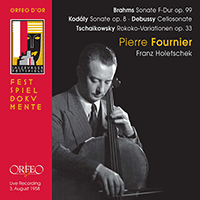Pierre Fournier
Often dubbed ‘the aristocrat of cellists’ because of his smooth, refined sound, Pierre Fournier was a musician very much of the Franco-Belgian tradition, studying with Paul Bazelaire and André Hekking at the Paris Conservatoire (where, like many successful alumni, he later became a professor himself ) and associating with such players as Jacques Thibaud and Alfred Cortot as well as contemporary Paris-based composers. He and fellow French cellist Paul Tortelier were great friends. On one occasion backstage after a recital by Tortelier they exchanged compliments with great humour: ‘Paul, I wish I had your left hand’; ‘Pierre, I wish I had your right arm!’ A keen advocate of new music, Fournier was the dedicatee of sonatas by Martinů and Poulenc, and gave premières of concertos by Roussel, Martin and Martinů. He was highly regarded both as a soloist and a chamber musician (see Maurice Vieux’s entry in this book). Touring Europe and the USA with Szigeti, Primrose and Schnabel in 1947–1948 broadened his horizons significantly, both in terms of becoming well known across the Atlantic and also in playing chamber music with musicians from different traditions.
Fournier’s playing is characterised by a tight, almost sparse sound, exquisite accuracy of intonation and left-hand passagework, and a generally articulate but relatively sustained approach to phrasing. Although by no means averse to portamenti (especially in some of his earlier performances), his use of such expressive devices is discreet and moderate; this can make his playing sound a little remote, and on some of these recordings can even suggest a slight weakness of tonal projection; but at its best this approach helps to convey the music with simplicity. The recordings selected here demonstrate this well. His 1960 Bach Suite BWV 1007 is a considered performance at moderate tempi with a relatively legato approach, but nonetheless much subtle phrase shaping. A fine performance of Beethoven’s Cello Sonata, Op. 5 No. 2 with Schnabel (1947) is particularly atmospheric and intense at the outset, but opens out into some very energetic playing especially in the Rondo; Fournier later recorded complete cycles of Beethoven’s cello and piano works for Deutsche Grammophon with Friedrich Gulda (1959) and Wilhelm Kempff (1965). Amongst large-scale Romantic works Fournier’s Dvořák Concerto recording under Colin Davis from relatively late in his career (1973) seems a little thin and under-projected and perhaps shows slight waning of powers in older age; the much earlier (1941) performance of Tchaikovsky’s Variations on a Rococo Theme, however, has exceptional tonal vivacity and depth where required. The Brahms Double Concerto recording, live at the 1955 Edinburgh Festival with Francescatti, is an acquired taste, particularly owing to Francescatti’s fast vibrato and bright but rather thin tone, which can seem a little odd to modern ears. The clarity of sound and sense of reserved musicianship from both soloists, however, elevates this unhurried interpretation above many other performances taken at such steady speeds. (See Francescatti’s entry in this book for a 1959 studio recording of the same work.)
In twentieth-century repertoire Fournier’s performances of the Walton Concerto under the composer’s baton (1959), the Martin Concerto (1967, live première) and the Sonata which Poulenc wrote for Fournier and frequently performed with him (1971) are all engaging and intense, testifying to Fournier’s prowess and versatility and, as is often the case, demonstrating a more relaxed musicianship in newer, less well-known works.
Fournier’s legacy includes the Fournier Award, set up from the proceeds of a memorial concert organised by Ralph Kirschbaum, which promotes talented young artists via a recital at London’s Wigmore Hall and a CD issue, as well as giving bursaries to younger musicians studying at some of the UK’s specialist music schools.
© Naxos Rights International Ltd. — David Milsom (A–Z of String Players, Naxos 8.558081-84)

















